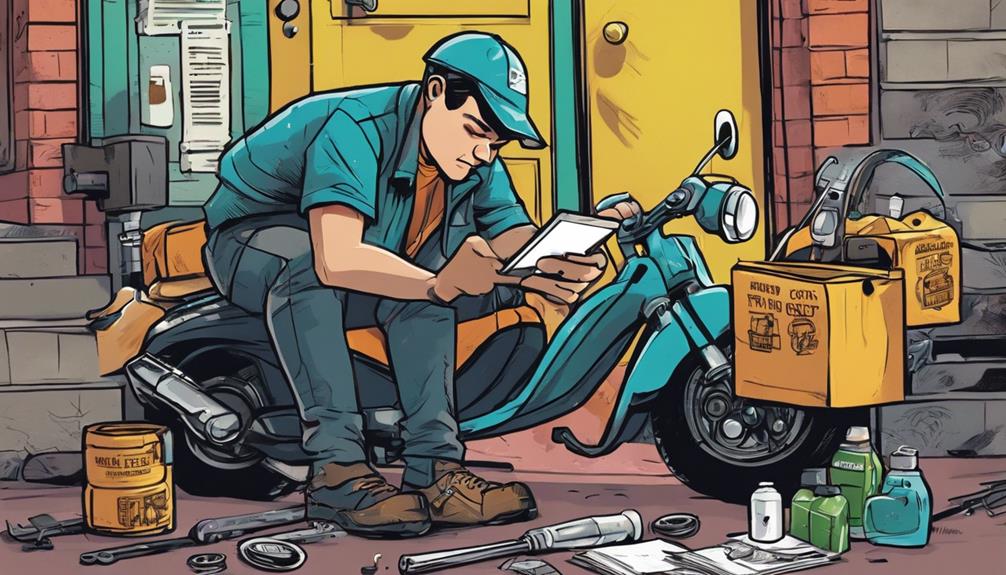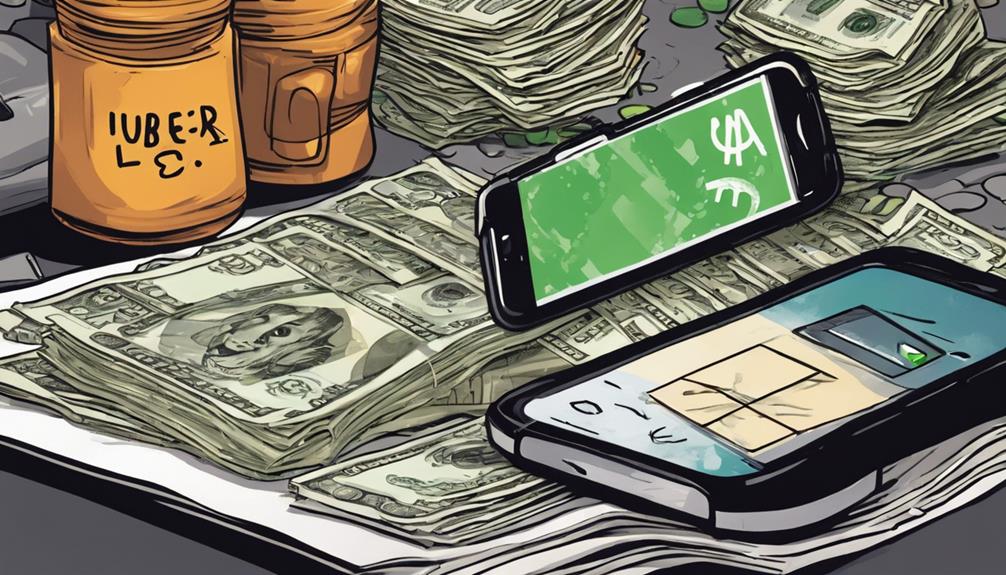Revealing the strategies for maximizing your Uber Eats driver earnings can significantly boost your income. It’s important to recognize that the average earnings typically amount to around $19 per hour, but this can increase with surge pricing and customer gratuities. Your choice of vehicle also plays a crucial role—scooters and bikes are more cost-effective to maintain, while cars are better suited for handling larger orders. Working during peak hours and accepting multiple requests can enhance efficiency and earnings. Providing excellent customer service is essential for receiving higher tips. Learning and implementing the most effective strategies will greatly improve your earning potential—stay tuned for more insight on optimizing your success.
Key Takeaways
- Earnings average around $39,448 annually, with hourly wages of approximately $19 based on a standard 40-hour workweek.
- Delivery payments vary between $2 to $4 per order, with tips significantly boosting overall income.
- Working during peak hours can maximize earnings through surge pricing and increased delivery requests.
- Vehicle choice impacts income; scooters and bikes lower costs while cars can carry larger orders.
Requirements to Become a Driver

To become an Uber Eats driver, you'll need a valid driver's license, a background check, and a reliable vehicle, whether it's a car, bike, or scooter. You'll also need to be at least 19 years old to meet age requirements.
A smartphone is essential for accessing the Uber Eats driver app, where you'll receive orders and navigate to delivery locations.
Maintaining your vehicle is vital for efficient deliveries; regular checks can prevent breakdowns and guarantee you're always ready to hit the road.
Finally, familiarize yourself with your local area to optimize delivery routes.
Meeting these requirements will set you up for a successful experience as an Uber Eats driver, allowing you to start earning money on your own schedule.
Overview of Average Earnings

Now that you understand the requirements to become an Uber Eats driver, it's important to look at what you can expect to earn in this role.
On average, you could make about $39,448 annually or around $19 per hour, assuming a standard 40-hour workweek. However, your earnings can vary considerably based on factors like your location, hours worked, and performance.
Typically, each delivery pays between $2 to $4, plus additional trip supplements that account for distance and time. Surge pricing during peak hours can boost your earnings, and customer tips can further enhance your income.
Keep in mind that while you might earn well in busy areas, earnings may fluctuate during off-peak times.
Factors Affecting Driver Income

Several key factors influence your income as an Uber Eats driver, shaping both your earning potential and day-to-day experience. Your earnings can vary greatly based on demand, competition, and local tipping habits. Here's a quick overview:
| Factor | Impact on Earnings |
|---|---|
| Market Demand | Higher demand increases orders, boosting income. |
| Tipping Behavior | Generous tips can markedly raise your total earnings. |
| Local Competition | More competitors may lead to fewer delivery requests. |
Impact of Vehicle Choice

Your choice of vehicle can considerably influence your earnings as an Uber Eats driver, affecting everything from delivery speed to operating costs.
If you opt for a scooter or bike, you'll benefit from lower operating expenses and greater maneuverability, allowing you to navigate congested areas quickly. This can lead to more deliveries within the same timeframe.
On the other hand, using a car enables you to cover longer distances and transport larger orders, but you'll face higher fuel and insurance costs.
Ultimately, the right vehicle can help maximize your efficiency and earnings, so consider your local environment and delivery patterns when making your choice.
Each option has its pros and cons, impacting your overall profitability.
Managing Maintenance Costs

Choosing the right vehicle can improve your delivery efficiency, but managing maintenance costs is just as important for maximizing your earnings as an Uber Eats driver. Understanding your expenses can help you make informed decisions. Here's a breakdown of typical maintenance costs for different vehicle types:
| Vehicle Type | Average Monthly Cost | Key Considerations |
|---|---|---|
| Scooter/Bike | $50 | Lower fuel and insurance |
| Compact Car | $150 | Higher fuel and upkeep |
| SUV | $250 | More storage, but costly |
Keep track of these expenses to see how they affect your net earnings. Regular maintenance can prevent larger issues, saving you money in the long run and ensuring you stay on the road longer.
Strategies to Boost Earnings

Implementing smart strategies can considerably enhance your earnings as an Uber Eats driver.
First, focus on working during peak hours, when demand spikes and surge pricing kicks in. Familiarize yourself with busy restaurant areas to maximize your delivery opportunities.
Consider accepting multiple delivery requests when feasible, as this can save time and increase your overall pay. Always provide excellent service to encourage generous tips; a friendly demeanor can make a difference.
Additionally, utilize the Uber Eats app's features to track your earnings and optimize your routes.
Finally, stay informed about any promotions or bonuses offered by Uber Eats, as these can provide significant boosts to your income.
Exploring Additional Income Streams

While boosting earnings through Uber Eats is important, exploring additional income streams can further enhance your financial stability and flexibility.
Consider diversifying your income by signing up for multiple delivery platforms, like DoorDash or Grubhub. This way, you can maximize earnings, especially during peak hours.
You might also explore rideshare driving, which allows you to make money while waiting for food delivery requests.
Alternatively, freelance work or online tutoring can provide consistent side income.
Task-based gigs, like dog walking or house cleaning, can fill your schedule during slow delivery times.
Frequently Asked Questions
How Do Seasonal Trends Impact Uber Eats Driver Earnings?
Seasonal trends impact your earnings by fluctuating demand. For instance, holidays often boost order volume, while summer may slow it down. Adapting your schedule to these changes can help you maximize your income throughout the year.
What Insurance Coverage Is Needed for Uber Eats Drivers?
As an Uber Eats driver, you'll need personal auto insurance that covers business use, plus liability coverage for accidents. Consider additional coverage options like collision and extensive to protect your vehicle during deliveries.
Can Uber Eats Drivers Work Part-Time?
Yes, you can work part-time as an Uber Eats driver. This flexibility allows you to choose your hours, fitting deliveries around your schedule, whether you're balancing a job, studies, or other commitments.
How Does the Rating System Affect Driver Earnings?
Imagine you finish a delivery and receive five stars. This high rating boosts your visibility in the app, attracting more orders. A better rating means more earnings, as customers often prefer highly-rated drivers for their food deliveries.
What Tax Implications Should Uber Eats Drivers Consider?
As an Uber Eats driver, you should consider taxes on your earnings, including self-employment tax and deductible expenses. Keeping accurate records of your mileage and expenses will help minimize your tax liability come filing season.
Conclusion
So, as you hit the streets with your Uber Eats app, remember you're not just delivering food; you're crafting your financial journey.
By understanding the ins and outs of earnings, maneuvering the peaks and valleys of demand, and making savvy choices about your ride, you'll watch your income soar like a freshly launched balloon.
Embrace the gig life, tweak your strategies, and let the road ahead lead you to greater profits and newfound freedom.
Your earning potential is just a drive away!









